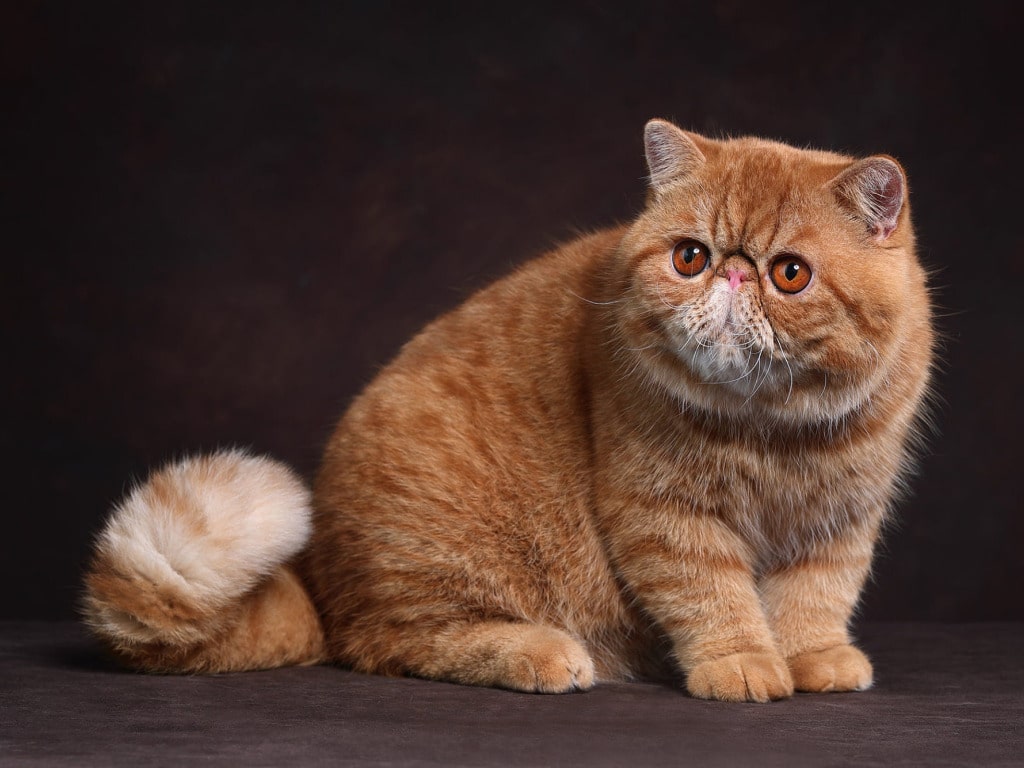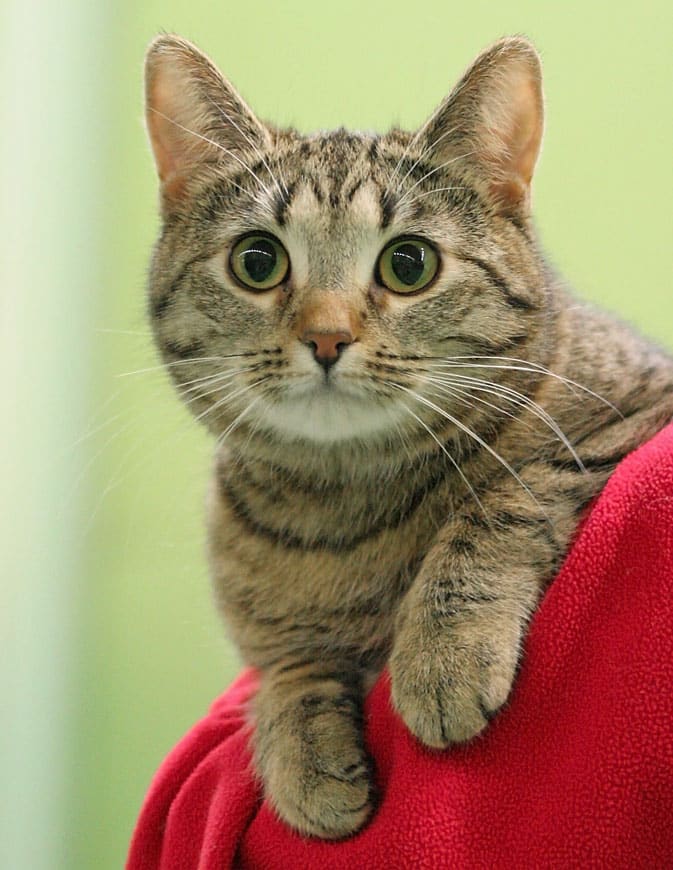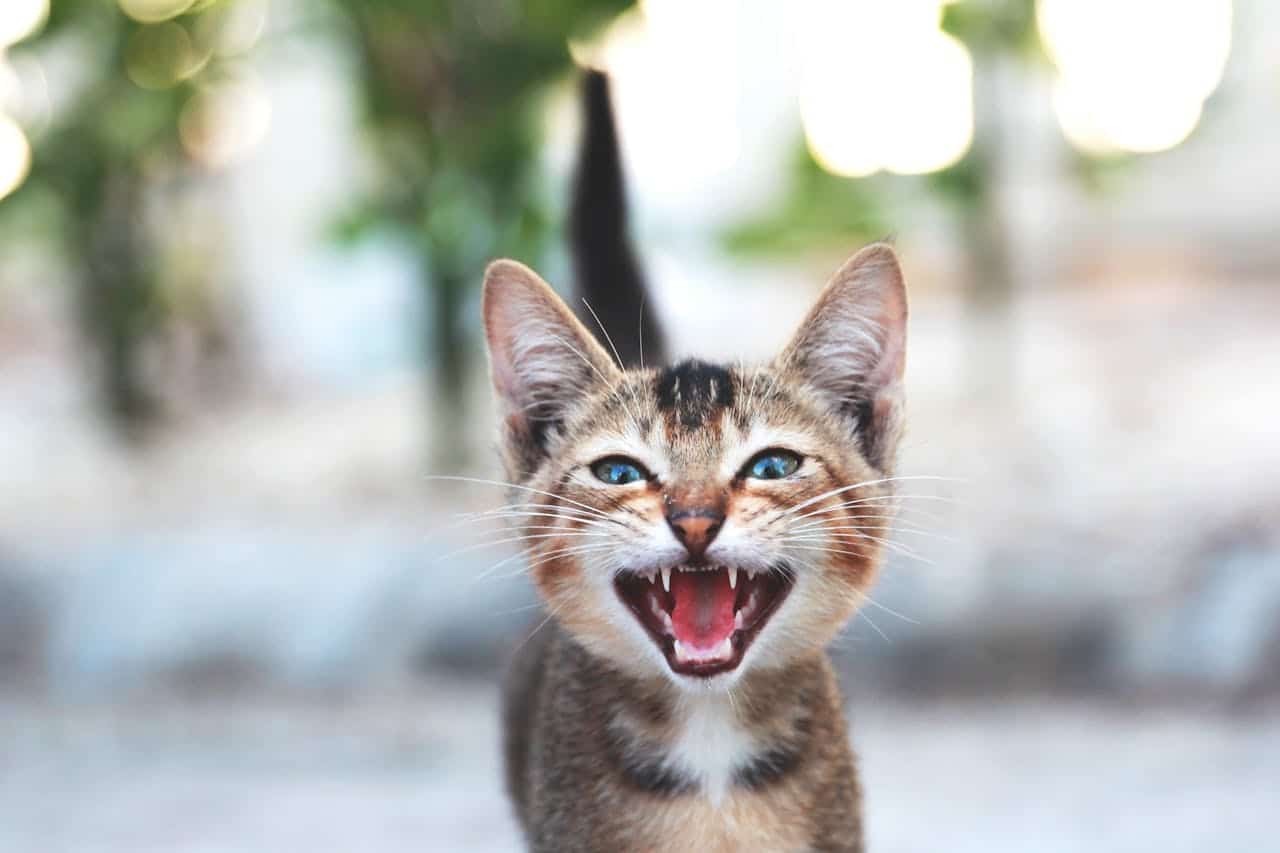
Exotic Shorthair Cats: Care and Personality | What You Need to Know If You’re Thinking of Getting an Exotic Shorthair Cat
This post contains affiliate links. Read the full disclosure here.
- Exotic Shorthair cats resulted from breeding Persian cats with American Shorthairs.
- They are known for their teddy bear-like appearance.
- They are affectionate cats that aren’t very active.
- They have a lifespan of 12–15 years.
- Exotic Shorthair cats are ideal for first-time cat owners.
Are you a first-time cat owner looking for a low-maintenance feline companion? If so, you might find the Exotic Shorthair to be the perfect fit for your home. Originating from a fascinating breeding experiment in the mid-20th century, Exotic Shorthair cats combine the luxurious features of the Persian cat with the convenience of a short coat.
In this guide, we’ll go into everything you need to know about caring for and understanding the personality of this delightful breed. From their unique history to their special care needs, you’ll gain valuable insights into welcoming an Exotic Shorthair into your life.
Brief History
Unlike many long-established cat breeds, the Exotic Shorthair is a relative newcomer, arising from a breeding experiment in the mid-20th century.
American Shorthair breeders in the 1950s sought to introduce the stunning silver coat and mesmerizing green eyes of the Persian into their own breed. They embarked on a breeding program, secretly crossing American Shorthairs with Persians. They also initially crossed with the Burmese and Russian Blue.
The resulting kittens possessed the desired physical characteristics – a plush, dense coat with shorter fur than a traditional Persian and the captivating features that make Persians so beloved.
However, the unexpected popularity of these Persian-American Shorthair crosses caused a stir. Traditional American Shorthair breeders were concerned about the dilution of their breed’s standard. This led to the creation of a stricter standard for American Shorthairs, effectively disqualifying cats with any signs of Persian influence.
Fortunately, a champion for the new breed emerged. Jane Martinke, a Cat Fanciers’ Association (CFA) judge and American Shorthair breeder, recognized the unique qualities of the Persian-Shorthair mix. She spearheaded the movement to establish them as a distinct breed.
In 1966, the CFA officially recognized the breed as the Exotic Shorthair, a name reflecting their exotic appearance and Persian lineage. In 1987, it stopped allowing Exotic to shorthair outcrosses, making the Persian the sole permissible outcross breed.
The Exotic Shorthair cat’s popularity continued to grow, gaining recognition from other major cat associations worldwide. Today, they are a cherished breed, offering cat lovers the undeniable charm of a Persian with the convenience of a shorter coat.
Physical Features
The Exotic Shorthair cat, often hailed as the “lazy man’s Persian,” is a delightful breed that combines the plush features of the Persian with the convenience of a short coat. These cats typically stand at 10–12 inches in height and weigh between 8 and 15 pounds, with males usually being larger than females. Their sturdy, muscular build and broad chest give them a robust appearance.
Among the Exotic Shorthair cats’ distinct features are their round faces and large, expressive eyes, which often come in the colors blue, green, or copper. In addition, their small, rounded ears set low on the head, full cheeks, and short, dense coat contribute to their teddy bear-like appearance.
On the other hand, their coat comes in a wide variety of colors and patterns. They are not hypoallergenic, as they produce the same allergens found in other breeds, which can affect individuals with cat allergies.

Personality
Bred to combine the Persian’s gentle demeanor with the American Shorthair’s easygoing nature, Exotic Shorthair cats are known for their endearing and quiet nature, making them a joy to have in any home. They are affectionate and gentle, often forming strong bonds with their family members.
In terms of activity, these felines have relatively low energy levels compared to other breeds. They enjoy playtime and will happily engage with toys, but they do so in a gentler, more relaxed manner. This makes them suitable for smaller living spaces where large, active play areas are not feasible.
Exotic Shorthair cats are also known for their independence. While they cherish the company of their humans, they are quite content to spend time alone, making them an excellent choice for individuals who work during the day.

When it comes to compatibility, these cats are generally good with children and other pets. They tend to be tolerant and easygoing, which helps them get along well in a household with multiple animals or in families with younger members, provided the children are taught to handle them gently.
RELATED ARTICLE: Understanding Cat Behaviors: 140 Cat Behaviors Explained
Health Issues & Lifespan
Exotic Shorthair cats typically enjoy a lifespan of 12–15 years, a testament to their robust nature. However, prospective owners should be aware of certain health issues that can affect this breed.
- Brachycephalic Respiratory Syndrome. One of the key factors influencing Exotic Shorthair health is their brachycephalic facial structure. This term refers to their adorable squished-in faces, a trait inherited from their Persian ancestors. While undeniably cute, this flat face can lead to breathing difficulties due to narrowed nostrils and an elongated soft palate. Be aware of signs of respiratory distress, such as labored breathing, snorting, or open-mouthed breathing, especially during hot weather. Keeping your Exotic Shorthair cool and avoiding strenuous activity is crucial.
- Eye Problems. Another area to be mindful of is their eyes. With their large, prominent eyes, Exotic Shorthair cats are prone to certain eye problems. Entropion, where the eyelid folds inward, and cherry eye, a protrusion of the tear gland, are both possibilities. Regular eye cleaning with a vet-recommended solution can help prevent irritation. Progressive retinal atrophy (PRA), a genetic condition that can lead to vision loss, is also a concern. Responsible breeders should screen their breeding stock for PRA to minimize its occurrence.
- Polycystic Kidney Disease (PKD). Perhaps the most significant health concern for Exotic Shorthairs, this inherited condition is one where cysts develop in the kidneys, eventually leading to kidney failure. Luckily, a simple DNA test can identify PKD-affected cats before breeding. Always ask breeders about PKD testing and choose a breeder who prioritizes the health of their cats.
- Obesity. This is another health condition that Exotic Shorthair cats can be at risk for, particularly as they age. Their less active nature can contribute to weight gain, which in turn can exacerbate other health issues. A balanced diet and portion control are key to preventing obesity and its associated complications.
Regular veterinary check-ups, a proper diet, and a comfortable living environment can help ensure a long and happy life for these endearing companions.

Special Care Needs
Despite their luxurious coats, Exotic shorthair cats are surprisingly low-maintenance. However, there are still specific aspects of their care to consider to ensure their well-being. Let’s explore how to keep your Exotic Shorthair feeling their best.
Grooming
Unlike their long-haired Persian cousins, Exotic Shorthair cats have a plush, short coat that requires minimal upkeep. A weekly brushing with a metal comb is sufficient to remove loose hair and prevent matting. This routine brushing also strengthens the bond between you and your feline friend.
While Exotics don’t require regular baths, some owners find that a bath every few months helps maintain their coat’s vibrant shine. Consult your veterinarian for guidance on bath frequency and appropriate shampoos for your cat’s sensitive skin.
Exercise & Play
Exotic Shorthair cats are not known for being energetic athletes. These gentle souls are perfectly content lounging around the house. However, some form of exercise is still vital for their physical and mental health. Interactive toys that mimic hunting, like feather wands or puzzle feeders, provide short bursts of activity that keep them stimulated.
Climbing structures and scratching posts also encourage natural behaviors and exercise. Remember, short and frequent playtime sessions are ideal for this breed.
Attention
Unlike some independent cat breeds, Exotic Shorthair cats are known for their affectionate nature. They often enjoy following their humans around the house, seeking out moments of cuddles and petting. A gentle head scratch or a brush behind the ears can be a welcome sign of affection for these cuddly felines.
While they appreciate your company, these cats are also comfortable with some alone time. Their adaptability makes them suitable for busy households or those with moderate work schedules. That being said, providing them with enriching activities and scratching posts will keep them occupied while you’re away.
Special Care: Addressing Brachycephalic Needs
As previously mentioned, Exotic Shorthair cats have a brachycephalic facial structure. This adorable feature comes with some special considerations. Their short face can make them more susceptible to overheating. During hot weather, provide ample access to cool water and air-conditioned spaces.
Their flat face can also make cleaning their eyes a daily necessity. A gentle wipe with a damp cloth around the eyes can prevent tear stains and irritation. If you notice any excessive discharge or redness, consult your veterinarian.

Fun Facts
Here are some quirky facts that will endear you to this captivating breed:
- The Exotic Shorthair cat wasn’t originally intended to be a distinct breed. They emerged in the 1960s as a result of breeding programs aimed at creating Persians with shorter coats.
- Some Exotic Shorthair kittens are born with long hair, just like their Persian ancestors! These surprise longhairs may be reclassified as Persians or Exotic longhairs, depending on the breed registry.
- The International Cat Association humorously suggests that Exotic Shorthairs are Persians dressed in pajamas, highlighting their laid-back nature and easy-care coat.
- Due to their resemblance to Persians with a shorter coat, Exotic Shorthair cats were once nicknamed the “Sterling” or the “Shorthaired Persian.”
- Initially, breeders aimed for the breed to have a silver coat, proposing “Sterling” as their name. However, the diverse colors that emerged led to the fitting name “Exotic Shorthair.”
- While some cats are known for their impressive leaps, Exotic Shorthairs are more content lounging around. Their stocky build and short legs make them better suited for cuddling than conquering high places.
- Exotic Shorthair cats come in a dazzling array of coat colors and patterns. From solid white or black to bi-color and calico, these felines offer a variety of stunning looks to suit any preference.
- These cats are also known for their sharp cognitive abilities and quick learning skills.
- With soft voices, they communicate in a much more subdued manner compared to other vocal breeds.
Who is the Ideal Owner of the Exotic Shorthair Cat?
The Exotic Shorthair cat can make a wonderful companion, but it’s important to consider your lifestyle to ensure a good fit for both you and your feline friend. Here’s a breakdown to help you decide:
- First-Time Cat Owners: Their low-maintenance grooming and exercise needs make Exotic Shorthairs an excellent choice for those new to cat ownership.
- Cat Lovers Who Crave Affection: These gentle souls adore attention and will shower you with purrs and cuddles. If you seek a loving lap cat, an Exotic Shorthair can be a perfect match.
- Calm Demeanor: Individuals who lead a peaceful lifestyle will find a kindred spirit in the Exotic Shorthair, as these cats are known for their gentle and easygoing nature.
- Busy Individuals: Their adaptability makes them suitable for those with moderate work schedules. They’re content with some alone time as long as you provide enriching activities.
- Apartment Dwellers: Their lower energy levels make them well-suited for apartment living. Owners should have a living space that accommodates indoor activities, as these felines do not require extensive outdoor exercise. They’ll be happy entertaining themselves with toys and exploring their vertical space.
- Families with Older Children: These easygoing cats can thrive in families with older children who understand proper cat handling. However, their gentle nature may not be suited for rowdy households with very young children.
Final Thoughts
Exotic Shorthair cats offer a blend of elegance and ease that cat lovers of all experience levels can appreciate. With their gentle demeanor, low-maintenance grooming requirements, and adaptable nature, they make wonderful companions for a variety of lifestyles.
Whether you’re a first-time cat owner seeking a furry friend to share your home or an experienced pet lover looking for a laid-back addition to your family, this breed’s charm and personality are sure to win you over. So, if you’re thinking of adding a feline friend to your life, why not consider the affectionate and endearing Exotic Shorthair?
Frequently Asked Questions
What are Exotic Shorthair cats?
Exotic Shorthairs are a breed of cat developed by breeding Persians with shorthaired breeds. They share the Persian’s charming looks with a delightfully low-maintenance coat.
Where do Exotic Shorthair cats come from?
The United States is where Exotic Shorthairs originated in the 1960s. Breeders aimed to create Persian cats with shorter coats, resulting in this unique breed.
How big do Exotic Shorthair cats get?
Exotic Shorthairs are medium-sized cats, reaching weights between 8 and 15 pounds.
Are Exotic Shorthair cats healthy?
With proper care, Exotic Shorthairs can live healthy lives. However, their flat faces can cause breathing difficulties, and they require screening for certain genetic conditions.
Are Exotic Shorthair cats hypoallergenic?
No, Exotic Shorthairs are not hypoallergenic. While they shed less than some breeds, they still produce allergens in their saliva and dander.
Are Exotic Shorthair cats affectionate?
Yes, Exotic Shorthairs are known for their affectionate personalities. They crave attention and enjoy cuddling with their humans.
Are Exotic Shorthair cats friendly?
Exotic Shorthairs are generally friendly cats. They tend to get along well with families and other pets, especially with gentle handling.
Are Exotic Shorthair cats cuddly?
Absolutely! These gentle souls love to cuddle and will readily seek out lap time and petting sessions.
Do Exotic Shorthair cats like to be held?
Many Exotic Shorthairs enjoy being held, but as with any cat, their comfort level can vary. Observe your cat’s body language and hold them gently for as long as they seem content.
Can Exotic Shorthair cats go outside?
While possible, it’s generally safer to keep Exotic Shorthairs indoors. Their flat faces can make them vulnerable to overheating, and they may be more susceptible to dangers outdoors.
How long do Exotic Shorthair cats live?
With proper care, Exotic Shorthairs can have a lifespan of 12 to 15 years.
Are Exotic Shorthair cats rare?
No, Exotic Shorthairs are not a rare breed. They are recognized by most major cat registries.
How much do Exotic Shorthair cats cost?
The cost of an Exotic Shorthair kitten can vary depending on breeder reputation, pedigree, and location. Expect to pay anywhere from $1000 to $5000.
Featured Image Credit: 1 – Kati4 / GoodFon
Adams, C. (2024, April 1). Exotic Shorthair Cat: Breed Info, Pictures, Temperament & Facts. Catster.com. https://www.catster.com/cat-breeds/exotic-shorthair-cat/
Animal Elyseum. (2023, October 13). Exotic Shorthair. Animal Elyseum. https://www.animalelysium.com/cats/breed/exotic-shorthair/
Caplan, C. (2021, February 9). Exotic Shorthair cat: a snapshot of the breed. Love to Know Pets. https://www.lovetoknowpets.com/cats/exotic-shorthair-cat-snapshot-breed
Dickson P. (2024, January 12). Exotic Shorthair cat health problems: 10 vet-reviewed issues. Catster.com. https://www.catster.com/guides/exotic-shorthair-cat-health-problems/
Donnelly, C. (2024, January 29). Exotic Shorthair: cat breed profile, characteristics & care. The Spruce Pets. https://www.thesprucepets.com/exotic-shorthair-cat-breed-profile-4774331
Ellis, R. R. (2022, November 30). What is cat eye syndrome? WebMD. https://www.webmd.com/parenting/baby/cat-eye-syndrome-facts
Exotic Shorthair. (2024). VCA Animal Hospital.https://vcacanada.com/know-your-pet/cat-breeds/exotic-shorthair
Exotic Shorthair: a guide to care, training, personality, & more. (n.d.). Happy Hungry Pets. https://happyhungrypets.com/exotic-shorthair/
Exotic Shorthair breed profile. (2024). Cat-World. https://cat-world.com/exotic-shorthair-breed-profile/
Exotic Shorthair cat breed: info, pictures, overview and more. (2024).PetCurious. https://www.petcurious.com/cat-breeds/exotic-shorthair/
Exotic Shorthair cat: characteristics, personality, and breed information. (2024). Cats.com. https://cats.com/cat-breeds/exotic-shorthair
Exotic Shorthair cat: the ultimate breed guide with proven tips, techniques, training advice for new owners. (2024). MyBritishShorthair.com. https://mybritishshorthair.com/exotic-shorthair-cat/
Exotic Shorthair cat colors: complete guide. (2020). Exotic Shorthair Kitty. https://exoticsshorthairkitten.com/exotic-shorthair-cat-colors-complete-guide/
Exotic Shorthair colors: what colors can Exotic Shorthair cats be? (2022, August 12). Littr robot blog. https://www.litter-robot.com/blog/exotic-shorthair-colors/
Gunter, L. (2024, March 5). The average lifespan of an Exotic Shorthair: What you need to know. Pet Magazine. https://petmagzine.com/the-average-lifespan-of-an-exotic-shorthair-what-you-need-to-know/
Hitchcock, K. (2024, March 31). Exotic Shorthair cat breed: info, pictures, care, traits & facts. Hepper Blog. https://www.hepper.com/exotic-shorthair-cat/
Jones, L. (2022, April 20). Entropion in Cats. PetMD. https://www.petmd.com/cat/conditions/eyes/c_ct_entropion
Leeson, J. (2024, February6). Exotic Shorthair. PetMD. https://www.petmd.com/cat/breeds/exotic-shorthair
Mat. (2023, August). Understanding the Exotic shorthair cat breed: traits, care, and history. All About Cats. https://www.catcornerblog.com/exotic-shorthair-cat-guide/
Trupanion Staff. (2024, February 7). Exotic Shorthair cat breed guide. Trupanion. https://www.trupanion.com/pet-blog/article/exotic-shorthair
Trupanion Staff. (2024, February 14). Exotic Longhair Cat: a Breed Guide. Trupanion. https://www.trupanion.com/pet-blog/article/exotic-longhair
The ultimate guide to Exotic Shorthair cat. (2023). CatsLib. https://catslib.com/home/catdetail/17/exotic-shorthair/
Unraveling the allure of the Exotic Shorthair cat breed: a guide for cat enthusiasts. (2024). Cat Buzz. https://catbuzz.org/cat-breeds/exotic-shorthair/
Which cat breed is more active: Exotic Shorthair or Russian Blue. (2023). Cat Bandit. https://blog.catbandit.com/which-cat-breed-is-more-active-exotic-shorthair-or-russian-blue/

Reina Marie Gonzales is the Founder of Sharp Minds Content LLC. She’s also an entrepreneur and a writer with over 20 years of experience. Cat mom to the sweetest and most adorable Persian kitty, her other passions include personal development, self-love, spirituality, and self-empowerment. She considers herself a lifelong learner and always sees the glass half full.


